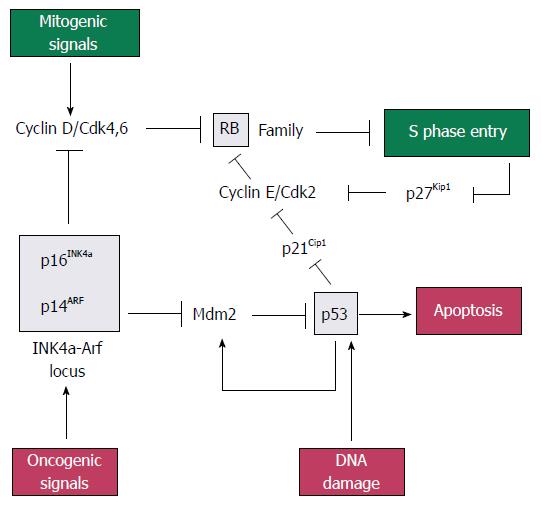Copyright
©2014 Baishideng Publishing Group Inc.
World J Gastroenterol. Oct 7, 2014; 20(37): 13343-13368
Published online Oct 7, 2014. doi: 10.3748/wjg.v20.i37.13343
Published online Oct 7, 2014. doi: 10.3748/wjg.v20.i37.13343
Figure 1 Cell cycle checkpoints.
Mitogenic signals activate cyclin D-dependent kinases, which phosphorylate RB and RB family proteins (p107 and p130) to facilitate entry into S phase. The p16INK4a protein inhibits cyclin D/Cdk4, 6 to activate RB and prevent entry into S phase. The p14ARF protein inhibits Mdm2 to induce p53, leading either to p53-dependent apoptosis or to induction of the Cdk2 inhibitor p21Cip1. The p21Cip1 protein inhibits cyclin E/Cdk2 and induces RB-dependent cell cycle arrest.
Figure 2 Schematic diagram of immunogene therapy.
A: Immunogene therapy with altered cancer cells, which are harvested from patients (autologous cells) or from established cancer cell lines (allogeneic) and then cultured in vitro and inactivated to yield a vaccine; B: Immunogene therapy with in vivo gene transfer; C: Immunogene therapy using altered immune cells.
Figure 3 Clinical trials regarding administration routes of gene therapy in pancreatic cancer.
- Citation: Liu SX, Xia ZS, Zhong YQ. Gene therapy in pancreatic cancer. World J Gastroenterol 2014; 20(37): 13343-13368
- URL: https://www.wjgnet.com/1007-9327/full/v20/i37/13343.htm
- DOI: https://dx.doi.org/10.3748/wjg.v20.i37.13343















